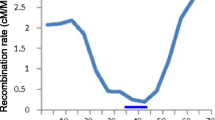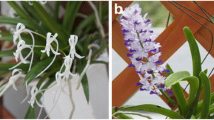Abstract
Conifers have larger genomes than most angiosperms, long generation times, and undergone relatively few chromosome duplications during their evolution. Thus, conifers are interesting targets for molecular evolutionary studies. Despite this, there have been few studies regarding their genome structure, and these studies are mostly limited to the Pinaceae. Our target species, Cryptomeria japonica, belongs to the Cupressaceae family, which is phylogenetically separated from the Pinaceae family by a few hundred million years, and is the most important timber tree in Japan, making investigation of its genome structure both interesting and worthwhile. We analyzed the sequences of eight random bacterial artificial chromosome (BAC) clones from C. japonica and compared them with sequences of comparable size from eight other model plants, including Arabidopsis thaliana and Pinus taeda. From this analysis, we identified several features of the C. japonica genome. First, the genome of C. japonica has many divergent repetitive sequences, similar to those of Physcomitrella patens and P. taeda. Additionally, some C. japonica transposable elements (TEs) seem to have been active until recently, and some might be unidentified novel TEs. We also found a putative protein-coding gene with a very long intron (approximately 70 kb). The three Pinaceae species whose genome sequences have been determined share these features, despite the few hundred million years of independent evolution separating the Pinaceae species from C. japonica.






Similar content being viewed by others
References
Ahuja MR, Neale DB (2005) Evolution of genome size in conifers. Silvae Genet 54(3):126–137
Banks JA, Nishiyama T, Hasebe M, Bowman JL, Gribskov M et al (2011) The Selaginella genome identifies genetic changes associated with the evolution of vascular plants. Science 20:960–963
Benson G (1999) Tandem repeats finder: a program to analyze DNA sequences. Nucleic Acids Res 27:573–580
Bird AP (1980) DNA methylation and the frequency of CpG in animal DNA. Nucleic Acids Res 8:1499–1504
Birol I, Raymond A, Jackman SD, Pleasance S, Coope R et al (2013) Assembling the 20 Gb white spruce (Picea glauca) genome from whole-genome shotgun sequencing data. Bioinformatics 29:1492–1497
Chandler VL, Walbot V (1986) DNA modification of a maize transposable element correlates with loss of activity. Proc Natl Acad Sci 83:1767–1771
Coulondre C, Miller JH, Farabaugh PJ, Gilbert W (1978) Molecular basis of base substitution hotspots in Escherichia coli. Nature 274:775–780
Deutsch M, Long M (1999) Intron-exon structures of eukaryotic model organisms. Nucleic Acids Res 27(15):3219–3228
Flavell RB (1984) Inactivation of gene expression in plants as a consequence of specific sequence duplication. Proc Natl Acad Sci 91:3490–3496
Futamura N, Totoki Y, Toyoda A, Igasaki T, Nanjo T et al (2008) Characterization of expressed sequence tags from a full-length enriched cDNA library of Cryptomeria japonica male strobili. BMC Genomics 9:383
Gadek PA, Alpers DL, Heslewood MM, Quinn C (2000) Relationships within Cupressaceae sensu lato: a combined morphological and molecular approach. Am J Bot 87(10):1480–1488
Gao C, Xiao M, Ren X, Hayward A, Yin J, Wu L, Fu D, Li J (2012) Characterization and functional annotation of nested transposable elements in eukaryotic genomes. Genomics 100:222–230
Goff SA, Ricke D, Lan TH, Presting G, Wang R et al (2002) A draft sequence of the rice genome (Oryza sativa L. ssp. japonica). Science 296:92–100
Gruenbaum Y, Naveh-Many T, Cedar H, Razin A (1981) Sequence specificity of methylation in higher plant DNA. Nature 292:860–862
Hamberger B, Hall D, Yuen M, Oddy C, Hamberger B et al (2009) Targeted isolation, sequence assembly and characterization of two white spruce (Picea glauca) BAC clones for terpenoid synthase and cytochrome P450 genes involved in conifer defense reveal insights into a conifer genome. BMC Plant Biol 9:106
Havecker ER, Gao X, Voytas DF (2004) The diversity of LTR retrotransposons. Genome Biol 5:225
Hizume M, Shibata F, Matsusaki Y, Garajova Z (2001) Chromosome identification and comparative karyotypic analyses of four Pinus species. Theor Appl Genet 105:491–497
Jurka J (1998) Repeats in genomic DNA: mining and meaning. Curr Opin Struct Biol 8:333–337
Jurka J (2000) Repbase update: a database and an electronic journal of repetitive elements. Trends Genet 9:418–420
Jurka J, Kapitonov VV, Pavlicek A, Klonowski P, Kohany O et al (2005) Repbase update, a database of eukaryotic repetitive elements. Cytogenet Genome Res 110:462–467
Kado T, Yoshimaru H, Tsumura Y, Tachida H (2003) DNA variation in a conifer, Cryptomeria japonica (Cupressaceae sensu lato). Genetics 164(4):1547–1559
Keeling CI, Dullat HK, Yuen M, Ralph SG, Jancsik S et al (2010) Identification and functional characterization of monofunctional ent-copalyl diphosphate and ent-kaurene synthases in white spruce reveal different patterns for diterpene synthase evolution for primary and secondary metabolism in gymnosperms. Plant Physiol 152:1197–1208
Kimura M (1980) A simple method for estimating evolutionary rate of base substitutions through comparative studies of nucleotide sequences. J Mol Evol 16:111–120
Kohany O, Gentles AJ, Hankus L, Jurka J (2006) Annotation, submission and screening of repetitive elements in Repbase: RepbaseSubmitter and Censor. BMC Bioinf 7:474
Kovach A, Wegrzyn JL, Parra G, Holt C, Bruening GE (2010) The Pinus taeda genome is characterized by diverse and highly diverged repetitive sequences. BMC Genomics 11:420
Kusumi J, Tsumura Y, Yoshimaru H, Tachida H (2000) Phylogenetic relationships in Taxodiaceae and Cupressaceae sensu stricto based on matK gene, chlL gene, trnL-trnF IGS region, and trnL intron sequences. Am J Bot 87(10):1480–1488
Lee E, Harris N, Gibson M, Chetty R, Lewis S (2009) Apollo: a community resource for genome annotation editing. Bioinformatics 25(14):1836–1837
Leslie AB, Beaulieu JM, Rai HS, Crane PR, Donoghue MJ, Mathews S (2012) Hemisphere-scale differences in conifer evolutionary dynamics. Proc Natl Acad Sci U S A 109:1217–16221
Liu W, Thummasuwan S, Sehgal SK, Chouvarine P, Peterson DG (2011) Characterization of the genome of bald cypress. BMC Genomics 12:553
Martienssen R (1998) Transposons, DNA methylation and gene control. Trends Genet 14:263–264
McLysaght A, Enright L, Skrabanek L, Wolfe KH (2000) Estimation of synteny conservation and genome compaction between pufferfish (Fugu) and human. Yeast 17:22–36
Meyer P, Niedenhof I, ten Lohuis M (1994) Evidence for cytosine methylation of non-symmetrical sequences in transgenic Petunia hybrida. EMBO 13:2084–2088
Misksche JP, Hotta Y (1973) DNA base composition and repetitious DNA in several conifers. Chromosoma 41:29–36
Miura A, Yonebayashio S, Watanabe K, Toyama T, Shimada H et al (2001) Mobilization of transposons by a mutation abolishing full DNA methylation in Arabidopsis. Nature 411:212–214
Moriguchi Y, Ujino-Ihara T, Uchiyama K, Futamura N, Saitou M et al (2012) The construction of a high-density linkage map for identifying SNP markers that are tightly linked to a nuclear-recessive major gene for male sterility in Cryptomeria japonica D. Don. BMC Genomics 13:95
Moritsuka E, Hisataka Y, Tamura M, Uchiyama K, Watanabe A et al (2012) Extended linkage disequilibrium in noncoding regions in a conifer, Cryptomeria japonica. Genetics 190:1145–1148
Neal DB, Wegrzyn JL, Stevens KA, Zimi AV, Puiu D et al (2014) Decoding the massive genome of loblolly pine using haploid DNA and novel assembly strategies. Genome Biol 15:R59
Nystedt B, Street NR, Wetterbom A, Zuccolo A, Lin YC et al (2013) The Norway spruce genome sequence and conifer genome evolution. Nature 497:579–584
Ohri D, Khoshoo TN (1986) Genome size in gymnosperms. Plant Syst Evol 153:119–132
Ohtsubo Y, Ikeda-Ohtsubo W, Nagata Y, Tsuda M (2008) GenomeMatcher: a graphical user interface for DNA sequence comparison. BMC Bioinf 9:376
Perlman PS, Boeke JD (2004) Ring around the retroelement. Science 2004(9):182–184
Price AL, Jones NC, Pevzner PA (2005) De novo identification of repeat families in large genomes. Bioinformatics 21:I351–I358
Razin A (1998) CpG methylation, chromatin structure and gene silencing—a three-way connection. EMBO 17:4905–4908
Rensing SA, Lang D, Zimmer AD, Terry A, Salamov A et al (2008) The Physcomitrella genome reveals evolutionary insights into the conquest of land by plants. Science 319:64
RepeatMasker (2013) Available at: http://www.repeatmasker.org/
Saitou N, Nei M (1987) The neighbor-joining method: a new method for reconstructing phylogenetic trees. Mol Biol Evol 4(4):406–425
Sakharkar MK, Chow VT, Kangueane P (2004) Distributions of exons and introns in the human genome. In Silico Biol 4:387–393
Schmutz J, Cannon SB, Schlueter J, Ma J, Mitros T (2010) Genome sequence of the palaeopolyploid soybean. Nature 463:178–183
Suzuki MM, Bird A (2008) DNA methylation landscapes: provocative insights from epigenomics. Nat Rev Genet 9:465–476
Tamura K, Peterson D, Peterson N, Stecher G, Nei M, Kumar S (2011) MEGA5: molecular evolutionary genetics analysis using maximum likelihood, evolutionary distance and maximum parsimony methods. Mol Biol Evol 28:2731–2739
The Arabidopsis Genome Initiative (2000) Analysis of the genome sequence of the flowering plant Arabidopsis thaliana. Nature 408:796–815
Thompson JD, Higgins DG, Gibson TJ (1994) ClustalW: improving the sensitivity of progressive multiple sequence alignment through sequence weighting, position-specific gap penalties and weight matrix choice. Nucleic Acids Res 22:4673–4680
Tsumura Y, Uchiyama K, Moriguchi Y, Ueno S, Ihara-Ujino T (2012) Genome scanning for detecting adaptive genes along environmental gradients in the Japanese conifer, Cryptomeria japonica. Heredity 109:349–360
Tuskan GA, DiFazio S, Jansson S, Bohlmann J, Grigoriev I et al (2006) The genome of black cottonwood, Populus trichocarpa (Torr. & Gray). Science 313:1596–1604
Vinogradov AE (1999) Intron-genome size relationship on a large evolutionary scale. J Mol Evol 49:376–384
Wegrzyn J, Liechty J, Stevens K, Wu L-S, Loopstra C, Vasquez-Gross H, Dougherty W, Lin B, Zieve J, Martínez-García P, et al. (2014) Unique features of the loblolly pine (Pinus taeda L.) megagenome revealed through sequence annotation. Genetics 196:891–909
Willyard A, Syring J, Gernandt DS, Liston A, Cronn R (2006) Fossil calibration of molecular divergence infers a moderate mutation rate and recent radiations for Pinus. Mol Biol Evol 24:90–101
Xu Z, Wang H (2007) LTR_FINDER: an efficient tool for the prediction of full-length LTR retrotransposons. Nucleic Acids Res 35:W265–W268
Yu J, Hu S, Wang J, Wong GKS, Li S et al (2002) A draft sequence of the rice genome (Oryza sativa L. ssp. indica). Science 2002(296):79–92
Acknowledgments
We would like to thank Alfred E. Szmidt, Junko Kusumi, and two anonymous referees for constructive comments on earlier drafts of the manuscript. This study was partially supported by the Program for Promotion of Basic and Applied Researches for Innovations in Bio-oriented Industry and by Grants-in-Aid for Scientific Research from the Japan Society for the Promotion of Science (nos. 22370083 and 26291082).
Conflict of interest
The authors declare that they have no conflict of interest.
Data archiving statement
Nucleotide sequences were deposited with the DNA Data Bank of Japan (DDBJ).
Author information
Authors and Affiliations
Corresponding author
Additional information
Communicated by P. Ingvarsson
Topical Collection on Genome Biology
Electronic supplementary material
Below is the link to the electronic supplementary material.
ESM 1
(DOCX 13806 kb)
Rights and permissions
About this article
Cite this article
Tamura, M., Hisataka, Y., Moritsuka, E. et al. Analyses of random BAC clone sequences of Japanese cedar, Cryptomeria japonica . Tree Genetics & Genomes 11, 50 (2015). https://doi.org/10.1007/s11295-015-0859-9
Received:
Revised:
Accepted:
Published:
DOI: https://doi.org/10.1007/s11295-015-0859-9




